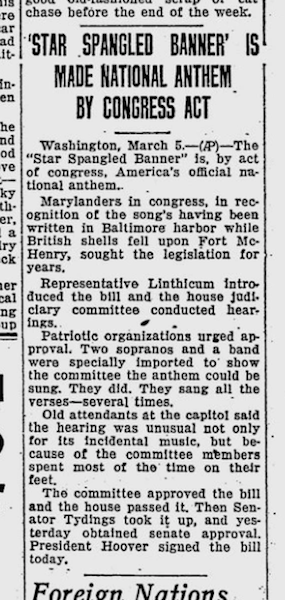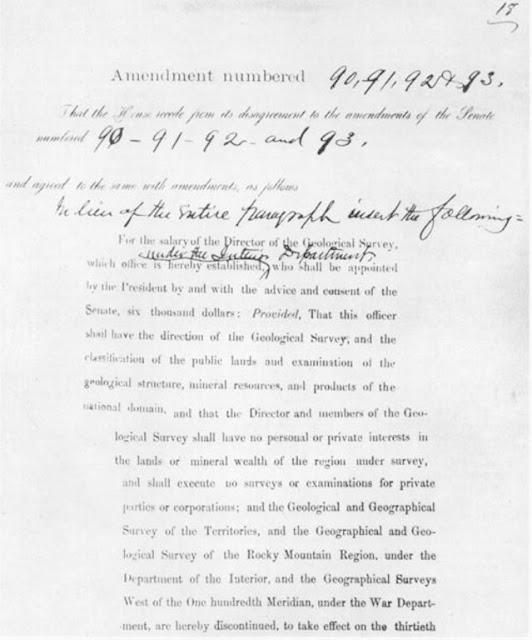On This Date In History
On March 3, 1931, President Herbert Hoover signs a congressional act making “The Star-Spangled Banner” the official national anthem of the United States.
On September 14, 1814, Francis Scott Key composed the lyrics to “The Star-Spangled Banner” after witnessing the massive overnight British bombardment of Fort McHenry in Maryland during the War of 1812. Key, an American lawyer, watched the siege while under detainment on a British ship and penned the famous words after observing with awe that Fort McHenry’s flag survived the 1,800 bomb assault.
After circulating as a handbill, the patriotic lyrics were published in a Baltimore newspaper on September 20, 1814. Key’s words were later set to the tune of “To Anacreon in Heaven,” a popular English song. Throughout the 19th century, “The Star-Spangled Banner” was regarded as the national anthem by most branches of the U.S. armed forces and other groups, but it was not until 1916, and the signing of an executive order by President Woodrow Wilson, that it was formally designated as such. In March 1931, Congress passed an act confirming Wilson’s presidential order, and on March 3 President Hoover signed it into law.
The U.S. Army Field Band performs the Star Spangled Banner at Fort McHenry for Defenders Day. Defenders Day commemorates the defense of Baltimore from September 12th through September 14th during the War of 1812. The events inspired Francis Scott Key to write the now famous words of the Star Spangled Banner, which became our National Anthem in 1931. Enjoy this beautiful rendition performed "O'er the ramparts." Lyrics by Francis Scott Key, Music by John Stafford Smith, arrangement by Master Sgt. Adrian Hernandez. Video by Sgt. First Class Jared Morgan.
https://www.youtube.com/watch?v=EIODUFpatkQ
Both “Hail, Columbia” and “My Country, ‘Tis of Thee” were both used as de facto national songs for the United States before the “The Star Spangled Banner” became the official national song.
"Hail Columbia" is now the personal anthem for the US Vice President. (‘Hail To The Chief’ is the personal anthem for the US President.)
“Hail Columbia”
https://www.youtube.com/watch?v=FyIqvZSuptk
“My Country, ’Tis Of Thee”
My Country ‘Tis of Thee (also known as “America”) is a patriotic hymn written by Samuel F. Smith in 1832, while a student at Andover Theological Seminary in Andover, Massachusetts. The melody had traveled around Europe in several variations, including “God Save the King.” Even Beethoven and Haydn had used the music in some of their own compositions. My Country ‘Tis of Thee (America) was the lyrical result of Samuel Smith’s drive to create a national hymn for the United States. In about 30 minutes on a rainy day, he wrote the now classic anthem. The first three verses encourage and invoke national pride, while the last verse was specifically reserved as a petition to God for His continued favor and protection of the United States of America.
https://www.youtube.com/watch?v=VKj7FLg3WVA
On March 3, 1863, during the Civil War, the U.S. Congress passes a conscription act (The Enrollment Act of 1863 (12 Stat. 731, enacted March 3, 1863) also known as the Civil War Military Draft Act,) that produces the first wartime draft of U.S. citizens in American history. The act called for registration of all males between the ages of 20 and 45, including aliens with the intention of becoming citizens, by April 1. Exemptions from the draft could be bought for $300 or by finding a substitute draftee. This clause led to bloody draft riots in New York City, where protesters were outraged that exemptions were effectively granted only to the wealthiest U.S. citizens.
Although the Civil War saw the first compulsory conscription of U.S. citizens for wartime service, a 1792 act by Congress required that all able-bodied male citizens purchase a gun and join their local state militia. There was no penalty for noncompliance with this act. Congress also passed a conscription act during the War of 1812, but the war ended before it was enacted. During the Civil War, the government of the Confederate States of America also enacted a compulsory military draft. The U.S. enacted a military draft again during World War I, in 1940 to make the U.S. ready for its involvement in World War II, and during the Korean War. The last U.S. military draft occurred during the Vietnam War.
Massive violent riots broke out in New York between rioters and Federal troops after the passing of the Enrollment Act for, among other things, the wealthy persons could ‘buy’ the way out of the draft and, black men were excluded.
On March 3, 1879, Congress establishes the United States Geological Survey, an organization that played a pivotal role in the exploration and development of the West.
Although the rough geographical outlines of much of the American West were known by 1879, the government still had astonishingly little detailed knowledge of the land. Earlier federal exploratory missions under men like Ferdinand Hayden and John Wesley Powell had begun to fill in the map, yet much remained to be done. Congress decided to transform the earlier system of sporadic federal geological explorations into a permanent government agency, the United States Geological Survey (USGS).
From the beginning, the USGS focused its efforts on practical geographical and geological investigations that might spur western economic development. Since the vast majority of the nation’s public land was in the West, the USGS became one of the federal government’s most important tools for encouraging the exploitation of western natural resources. Congress appointed Clarence King, a brilliant young mining engineer and geologist, as the first director. King, who had previously done considerable work for western mining companies, viewed the USGS as a tool for aiding further mineral exploitation. As a result, the first major reports produced under King’s tenure concerned the economic geology of two important mining districts, Nevada’s Comstock Lode and Colorado’s Leadville silver district.
King’s attempts to aid western mining won him praise from both mining companies and western congressmen, but King was eager to make his own fortune in the mining business. He resigned as director in 1881 to pursue what he hoped would be more lucrative opportunities. John Wesley Powell, a bold geologist-explorer who had led the first American explorations of the Grand Canyon, succeeded King as director.
Powell extended the work of the survey into new areas like paleontology and soon became controversial for his bold assertion that much of the arid West would remain unsettled without large-scale irrigation projects. The direct and plainspoken Powell was so closely associated with the USGS during his 14-year term as director that many people have mistakenly believed he was the first director of the agency. Despite his expansion of the survey’s mission, though, Powell never abandoned the practical economic emphasis established by King.
Subsequent directors of the USGS also remained true to King’s early focus on aiding the economic development of the West, providing topographical and geological maps that have continued to prove essential to the mineral, agricultural and hydraulic development of the region to this day.
Clarence King
John Wesley Powell




















No comments:
Post a Comment